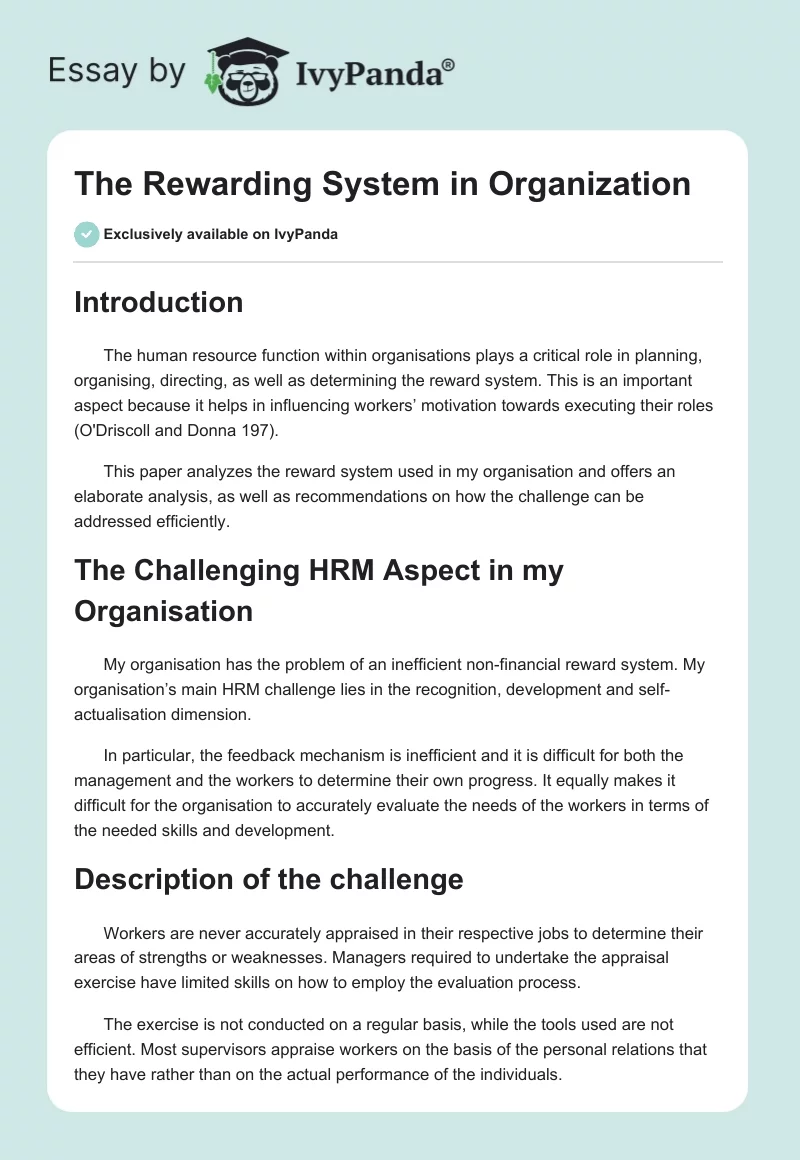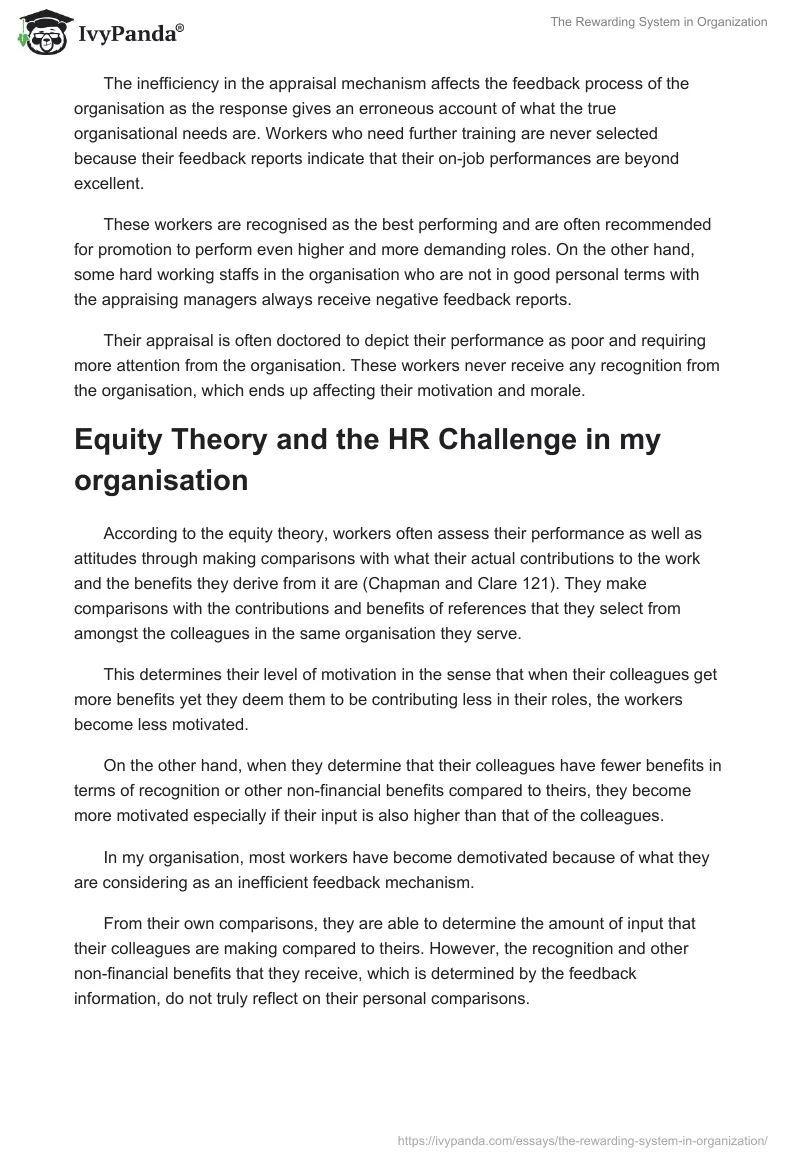Introduction
The human resource function within organisations plays a critical role in planning, organising, directing, as well as determining the reward system. This is an important aspect because it helps in influencing workers’ motivation towards executing their roles (O’Driscoll and Donna 197).
This paper analyzes the reward system used in my organisation and offers an elaborate analysis, as well as recommendations on how the challenge can be addressed efficiently.
The Challenging HRM Aspect in my Organisation
My organisation has the problem of an inefficient non-financial reward system. My organisation’s main HRM challenge lies in the recognition, development and self-actualisation dimension.
In particular, the feedback mechanism is inefficient and it is difficult for both the management and the workers to determine their own progress. It equally makes it difficult for the organisation to accurately evaluate the needs of the workers in terms of the needed skills and development.
Description of the challenge
Workers are never accurately appraised in their respective jobs to determine their areas of strengths or weaknesses. Managers required to undertake the appraisal exercise have limited skills on how to employ the evaluation process.
The exercise is not conducted on a regular basis, while the tools used are not efficient. Most supervisors appraise workers on the basis of the personal relations that they have rather than on the actual performance of the individuals.
The inefficiency in the appraisal mechanism affects the feedback process of the organisation as the response gives an erroneous account of what the true organisational needs are. Workers who need further training are never selected because their feedback reports indicate that their on-job performances are beyond excellent.
These workers are recognised as the best performing and are often recommended for promotion to perform even higher and more demanding roles. On the other hand, some hard working staffs in the organisation who are not in good personal terms with the appraising managers always receive negative feedback reports.
Their appraisal is often doctored to depict their performance as poor and requiring more attention from the organisation. These workers never receive any recognition from the organisation, which ends up affecting their motivation and morale.
Equity Theory and the HR Challenge in my organisation
According to the equity theory, workers often assess their performance as well as attitudes through making comparisons with what their actual contributions to the work and the benefits they derive from it are (Chapman and Clare 121). They make comparisons with the contributions and benefits of references that they select from amongst the colleagues in the same organisation they serve.
This determines their level of motivation in the sense that when their colleagues get more benefits yet they deem them to be contributing less in their roles, the workers become less motivated.
On the other hand, when they determine that their colleagues have fewer benefits in terms of recognition or other non-financial benefits compared to theirs, they become more motivated especially if their input is also higher than that of the colleagues.
In my organisation, most workers have become demotivated because of what they are considering as an inefficient feedback mechanism.
From their own comparisons, they are able to determine the amount of input that their colleagues are making compared to theirs. However, the recognition and other non-financial benefits that they receive, which is determined by the feedback information, do not truly reflect on their personal comparisons.
Causes of the Problem
The reward system lacks appropriate vertical integration, which is critical in driving workers’ motivation. The appraisal mechanism used, for instance, does not establish desired employee competencies against which the actual performance of the workers is supposed to be measured. Managers conducting the appraisal exercise give out scores basing on their own thoughts and the personal relations they have with the workers.
The performance, behaviours, as well as the competencies that the managers are evaluating does not integrate with important HR strategies that are required to produce an efficient reward system.
The organisation does not have internal policies that are important in guiding and ensuring that the resultant appraisal and feedback mechanism is efficient. There are no existing guiding principles that the managers base their appraisal process on.
Instead, each manager comes up with a system that he considers to be appropriate for guiding the whole process. This results in biased feedback reports whose main basis is on the kind of personal relationship that the manager holds with specific staffs in the organisation.
Solution
The organisation should consider using the 360-degree feedback mechanism in the evaluation of its employees. Such a mechanism will reduce instances of bias, where managers appraise workers basing on their personal relationships instead of applying professionalism.
The 360-degree feedback mechanism is more efficient because it is a continuous process that evaluates the performance of workers and provides reports that can be relied upon in determining the rewards for workers, such as promotions and recognitions (Oz and Deniz 280).
The 360-degree feedback mechanism will help in customising appraisal for each worker basing on their specific roles because of the heterogeneous nature of job skills and roles in my organisation. The feedback reports for each worker will be more acceptable because the appraisals are done from various quarters, including from the managers, colleagues, as well as the subordinates.
An average drawn out appraisal from all these analyses will give a more true reflection of the workers’ position than is the case with the current practise where only managers perform the appraisals and determine the feedback report.
A 360-degree feedback mechanism will also ensure that a vertically integrated reward strategy that is both deterministic and unitarist is achieved (Oz and Deniz 283). The need to involve more participants in the appraisal exercise will ensure that the reward system reflects on the mission and strategy of the organisation, and that it incorporates the organisation’s culture.
In other words, the desired employee competence, behaviours and performance will be determined in advance and used as the benchmark for appraising workers rather than basing on individual points of reference as is the case currently.
Implementation of the Solution
How
The reward system must be determined by the appraisal results that shall be achieved after conducting a 360-degree feedback. Appraisal will be conducted from all directions, including from the worker’s manager, his colleagues, as well as the subordinates. This should be done continuously as the worker’s actual performances are compared to the desired standards set out by the organisation (Murdoch 1263).
An analysis of all the appraisal results should produce one average record that should be communicated to the worker to convey his results. The average result should also be used as the main determinant of the worker’s reward value from the organisation.
When
The execution of the 360-degree feedback mechanism should be done continuously. Workers perform their duties and roles on a daily basis and, therefore, the appraisal should be done every day.
The feedback report may be issued periodically, such as after every four months after compiling all the numerous reports from the various sources conducting the evaluation. This will help the workers to put in the necessary changes that are needed to improve on their weak areas, while also enhancing performance on areas where they are strong.
By who
Appraisals should be conducted from three main sources within the organisation. The first source should involve the workers’ immediate manager or supervisor. The second source of appraisal should be colleagues working together in executing similar roles within the organisation. A third source should include subordinates working under a given worker.
These sources should be independent and work towards providing an objective result. The final feedback report should be prepared and conveyed to the worker by the manager, who will also use its findings to determine the appropriate reward for the worker.
Likely Obstacles
The reward system may remain to be inefficient due to lack of frank and honest judgment conducted during the appraisal (Ghorpade 140). For instance, colleagues may opt to provide an erroneous evaluation for fear of seeing their fellow workers being rewarded more benefits. There could also be laxity in implementing the feedback information in terms of marching it with the appropriate reward.
Conclusion
My organisation experiences an inefficient reward system that is not offering sufficient non-financial rewards mainly because of the poor feedback mechanism that is employed. Workers receive their appraisal feedback that does not accurately reflect on their actual performances.
This has affected the level of motivation within the organisation as workers feel their colleagues whose input are relatively lower are being rewarded more than can be compared to their own rewards.
The company should address this inefficiency by adopting use of the 360-degree feedback mechanism, which is more reliable and highly efficient. Rewarding workers using the reports of this system will be more acceptable and will help in driving the morale higher compared to the situation currently.
Works Cited
Chapman, Jonathan, and Clare Kelliher. “Influences On Reward Mix Determination: Reward Consultants’ Perspectives.” Employee Relations 33.2 (2011): 121-139. Print.
Ghorpade, Jai. “Managing Five Paradoxes Of 360-Degree Feedback.” Academy Of Management Executive 14.1 (2000): 140-150. Print.
Murdoch, Adrian. “Going Full Circle.” Accountancy International 122.1263 (1998): 48-48. Print.
O’Driscoll, Michael P., and Donna M. Randall. “Perceived Organisational Support, Satisfaction With Rewards, And Employee Job Involvement And Organisational Commitment.” Applied Psychology: An International Review 48.2 (1999): 197-209. Print.
OZ, Ozge, and Deniz Buyukkilic Seren. “Developing The Application Of 360 Degree Performance Appraisal Through Logic Model.” International Journal of Business & Social Science 3.22 (2012): 280-286. Print.


